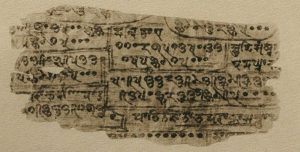Bill Casselman at the website of the American Mathematical Society:
 The Bakhshali manuscript is a mathematical document found in 1881 by a local farmer in the vicinity of the village of Bakhshali, near the city of Peshawar in what was then British India and is now Pakistan. It is written in ink on birch bark, a common medium for manuscripts in northwestern India throughout much of history. In the tough climate of India and neighbouring regions, such things deteriorate rapidly, and it is miraculous that this document has survived.
The Bakhshali manuscript is a mathematical document found in 1881 by a local farmer in the vicinity of the village of Bakhshali, near the city of Peshawar in what was then British India and is now Pakistan. It is written in ink on birch bark, a common medium for manuscripts in northwestern India throughout much of history. In the tough climate of India and neighbouring regions, such things deteriorate rapidly, and it is miraculous that this document has survived.
The Bakhshali manuscript is in a very damaged state, but is a valuable mathematical record nonetheless. It consists now of 70pages, but was probably once part of something much longer. Some of the pages we have are themselves broken up into fragments, and large parts are missing. Even the exact order of the pages has been a matter of conjecture, since the state in which it first came under careful examination is not necessarily the original order. The first edition of the manuscript was published by the Government of India in Calcutta in 1927, and its editor was G. R. Kaye. In 1995 a new edition was published, edited by Takao Hayashi as an extension of his PhD thesis at Brown University. He ordered the pages very differently from Kaye, and made a much more thorough translation.
The manuscript was donated to the Bodleian Library at Oxford University early in the twentieth century. Attempts to assess its age have generated much controversy–estimates have ranged, roughly, from 300 C.E. to 1200 C.E.
More here. [Thanks to Pramathanath Sastry.]
